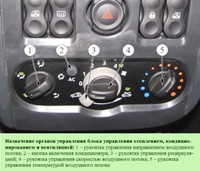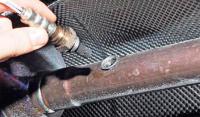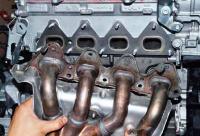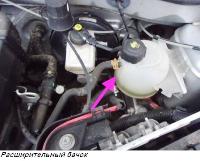Failure of the timing belt (timing) (breakage or shearing of teeth) will lead to the impact of the valves on the pistons due to the misalignment of the angles of rotation of the crankshaft and camshafts and, as a result, to costly engine repairs
Therefore, in accordance with the car maintenance regulations, we replace the belt every 120 thousand kilometers or after 6 years (whichever comes first), regardless of its condition.
At every maintenance, we recommend checking the condition of the belt.
The surface of the toothed part of the belt should not have folds, cracks, undercutting of the teeth and delamination of the fabric from the rubber.
The reverse side of the belt should not show wear, exposing the cord threads, and signs of burning.
Laminations should not be observed on the end surfaces of the belt.
The belt must be replaced if it shows traces of oil.
To assess the condition and replace the timing belt, remove the right support of the power unit and the right mudguard of the engine compartment.
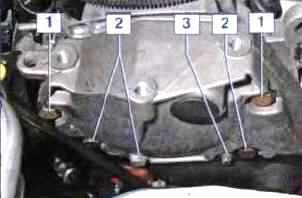
We unscrew the six bolts securing the top cover of the drive with a 16 head - two bolts 1, a 13 head - three bolts 2 and a 8 head - bolt 3.
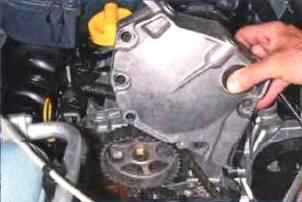
Remove the top timing cover
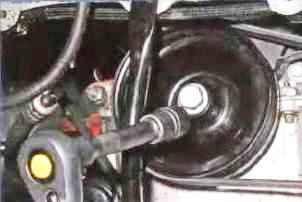
With a head of 18, turn the crankshaft clockwise and visually inspect the condition of the belt.
Without a tool, you can determine the belt tension.
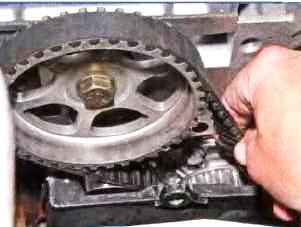
If the force of the thumb and forefinger of the hand manages to twist the leading branch of the belt (at the point located between the toothed pulleys of the camshaft and the coolant pump) by more than 60 ° - 70 °, then the belt is weakly tensioned, and it must be tightened.
Remove the bottom cover to adjust the belt tension.

With an 8 head with a ratchet, we unscrew the two bolts securing the lower timing cover.
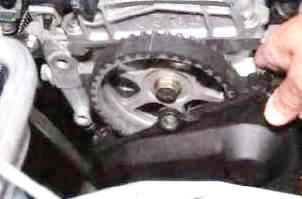
Remove the lower timing cover.
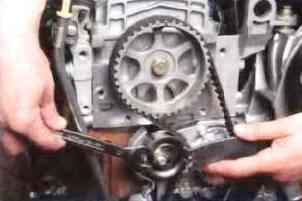
Having loosened the tightening of the tension roller fastening nut with a 16 wrench, with a special key (a wrench is suitable for tensioning the timing belt of front-wheel drive VAZ cars), turn the roller counterclockwise, tightening the belt.
In this position of the roller, tighten the nut of its fastening.

Turning the crankshaft clockwise for the bolt securing its pulley two turns, check the belt tension again and repeat the adjustment if necessary.
Install the removed parts in reverse order
To replace the timing belt, remove the auxiliary drive belt, the upper and lower timing covers.
When unscrewing the bolt securing the crankshaft pulley, it is necessary to block the shaft from turning.
For this You can use the window in the clutch housing, located on top under the thermostat housing.
Turning the crankshaft (an assistant is required), we observe the movement of the clutch cover in the window.
We make sure that one of the six bolts securing the casing to the flywheel appears in the window.

We stop the crankshaft from turning by inserting the blade of a power slotted screwdriver between the upper wall of the window in the clutch housing and the head of the casing mounting bolt.
Using the “18” head, unscrew the bolt securing the crankshaft pulley and remove the screwdriver from the clutch housing window.
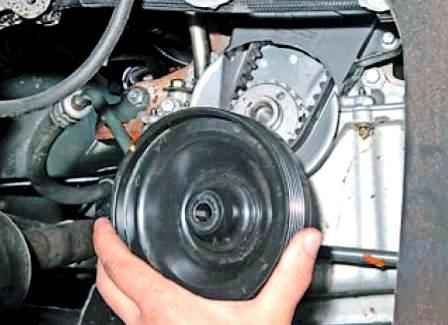
Remove the crankshaft pulley
If it is difficult to remove the pulley, we evenly pry it from different sides with a mounting spatula.
For subsequent crankshaft rotation, it is necessary to screw the pulley bolt into place.
In order for the bolt to completely screw into the threaded hole of the crankshaft nose, we install a spacer (sleeve or set of washers) between the bolt and the shaft nose.
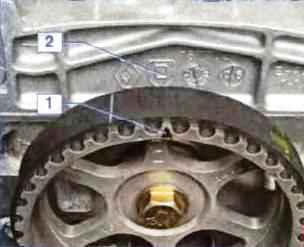
Before removing the belt, in order not to disturb the valve timing, it is necessary to set the crankshaft and camshafts to the TDC (top dead center) position of the compression stroke of the 1st cylinder.
We turn the crankshaft by the bolt of its pulley clockwise until mark 1 (holes in the shape of a triangle) coincides on the camshaft pulley with mark 2 (Dacia logo), through which the imaginary vertical axis of the pulley passes on the head cover cylinder block.
To check that the crankshaft is in the TDC position of the pistons of the 1st and 4th cylinders, a hole with an M10 thread is provided in the cylinder block, into which a special mounting pin with a threaded length of 75 mm must be screwed.
When the crankshaft is in the TDC position of the pistons of the 1st and 4th cylinders, the finger should rest against the milled area on the cheek of the crankshaft and block the shaft when trying to turn it clockwise.
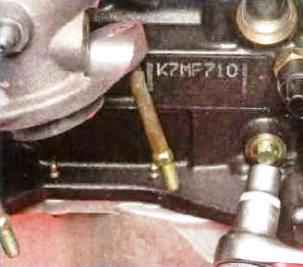
With a 14 head, we unscrew the plug from the threaded hole in the cylinder block located on the side of the block, in the region of the 1st cylinder - under the emergency oil pressure indicator sensor.
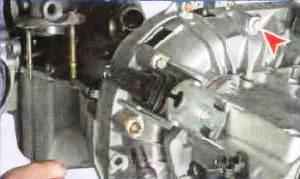
As a mounting pin, you can use the upper bolt of the gearbox to the cylinder block.
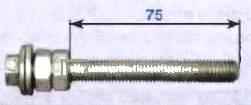
We screw two nuts onto the bolt and lock them so that the length of the threaded part is 75 mm.
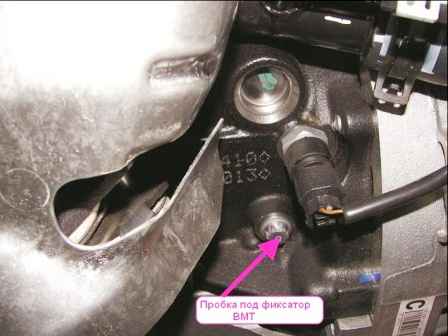
The fixture is made - we screw the mounting pin into the threaded hole of the cylinder block.
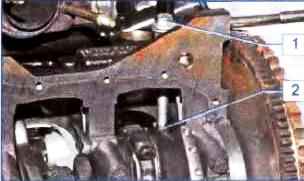
When the crankshaft is in the TDC position of the pistons of the 1st and 4th cylinders, the mounting pin 1 will screw into the hole to the end of its thread and rest against the milled platform 2 on the crankshaft web (for clarity, it is shown on the dismantled engine and with the pallet removed crankcase).
It will not be possible to turn the crankshaft clockwise
If, when screwing in the mounting pin, you feel that it rests, and the end of the nut on the finger does not touch the end of the boss of the hole in the cylinder block (there will be a gap between the nut and the boss), then turn the crankshaft a little counterclockwise by the bolt pulley fastening.
Then we screw the mounting pin into the hole of the block to the end (until the ends of the pin nut and the boss of the hole in the block touch) and turn the crankshaft clockwise until the cheek pad stops against the finger.
After loosening the tension roller fastening nut, turn the roller clockwise, reducing the tension of the timing belt.
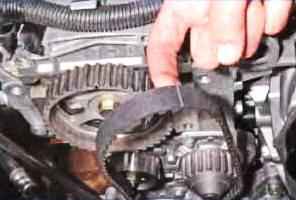
Remove the timing belt.
After removing the belt, the shafts must not be rotated so as not to bend the valves.

To replace the tension roller, unscrew the nut of its fastening and remove the tension roller.
Install the new tension pulley and timing belt in reverse order
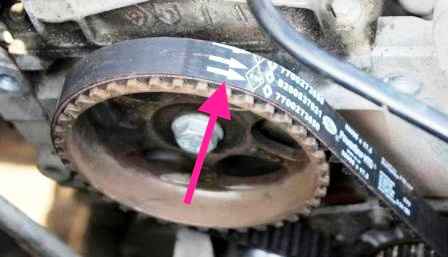
When installing a belt with arrows on it, orient it so that the arrows coincide with the direction of belt movement (clockwise)
Having installed the belt on the crankshaft pulley, we put the belt under the tension roller and put it on the pulleys of the camshaft and coolant pump.
We tighten the timing belt, as shown above.
Having unscrewed the mounting pin from the hole in the cylinder block, turn the crankshaft two turns clockwise by the pulley mounting bolt until the mark on the camshaft pulley coincides with the mark on the cylinder head cover.
Then we screw the mounting pin into the hole of the cylinder block to check the correct installation of the crankshaft in the TDC position of the pistons of the 1st and 4th cylinders (see above) and, if necessary, repeat the installation of the belt.
We turn the finger out of the hole in the cylinder block and put the plug in place.
Install the removed parts in reverse order.
Replace the accessory drive pulley bolt with a new one and tighten to the prescribed torque.
For reliable operation of the engine and ensuring the specified service life of the timing belt, it is better to check the belt tension using a strain gauge.
Tightening torques for fasteners when replacing the timing belt:
- - nut for fastening the timing belt tension roller - 50 Nm;
- - M10 bolt for fastening the upper timing cover - 44 Nm;
- - M8 bolt for fastening the upper timing cover - 22 Nm;
- - bolt for fastening the lower cover of the timing drive - 8 Nm;
- - bolt for fastening the accessory drive pulley - 30 Nm, tighten 80˚±5˚.







